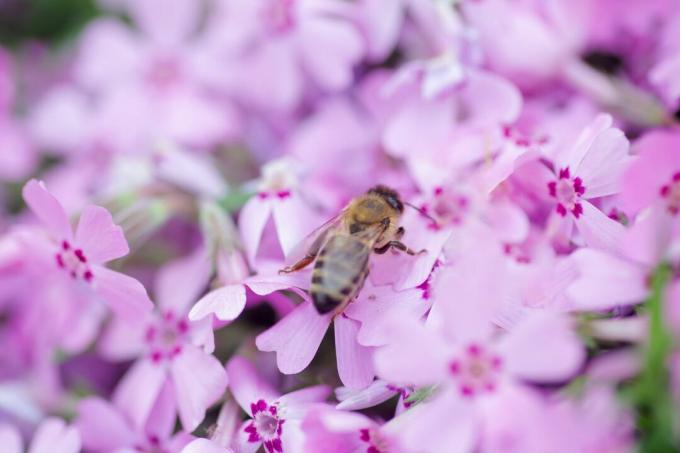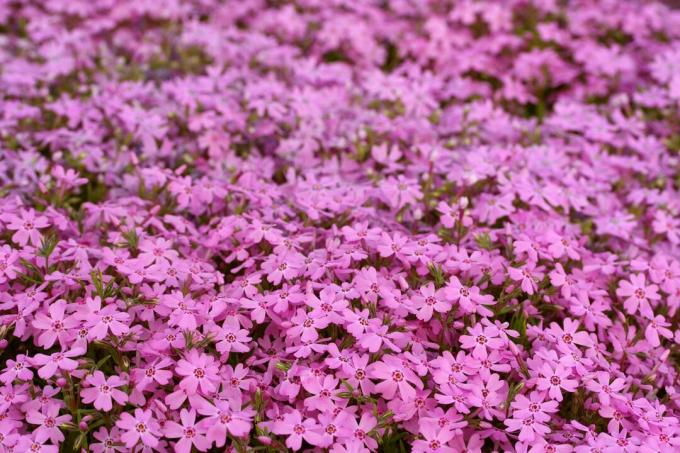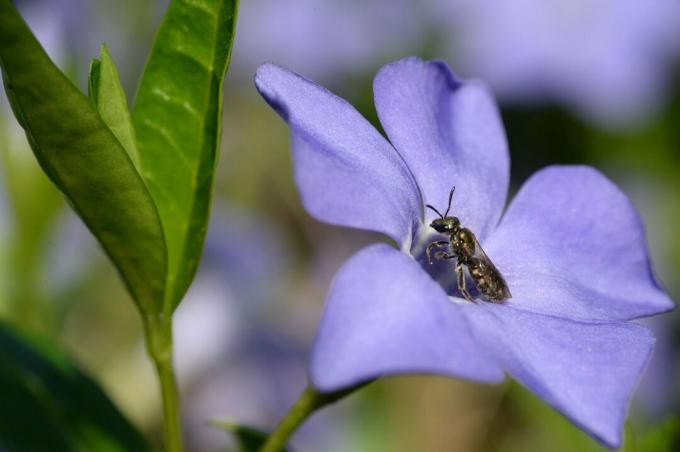Ground covers are a decorative and easy-care addition to any bed. But did you know that bees can also benefit from the plants? We introduce you to 15 bee-friendly ground covers for sun, shade and winter.

Among the beneficial insects in the garden, the bee is one of the best known and most popular for many. This is hardly surprising, given their impressive performance as pollinators - in fact, many plants in our gardens even depend on the help of bees. It is all the more regrettable that the number of bees, especially the highly specialized wild bee species, continues to fall.
contents
-
Bee-friendly ground covers for the shade
- Wood Anemone (Anemone nemorosa)
- Ivy (Hedera helix)
- Hepatica (Hepatica nobilis)
- Foam flower (Tiarella cordifolia)
- Astilbe (Astilbe)
-
Bee-friendly ground covers for the sun
- Thrift (Armeria maritima)
- Hot Stonecrop (Sedum acre)
- Blood-red cranesbill (Geranium sanguineum)
- Catnip (Nepeta)
- Carpet phlox (Phlox subulata)
-
Bee friendly and hardy ground cover
- Lesser periwinkle (Vinca minor)
- Carpet dogwood (Cornus canadensis)
- Lesser prunella (Prunella vulgaris)
- Creeping Bugles (Ajuga reptans)
- Fingerbush (Potentilla fruticosa)
Choosing bee-friendly plants is a good way to support the bees in your garden. Particularly groundcover are very bee-friendly and also benefit the gardener. They are easy to care for, can be used almost anywhere and, in contrast to lawn or gravel areas, often offer a good supply of food for the small animals. We will tell you here which plants are considered to be particularly bee-friendly ground covers.
Tip: Above all, you should focus on diversity: bees need an adequate supply of food all year round, which only a diverse garden can offer.
Seed mixtures like ours are therefore a great alternative to conventional individual plants Plantura bee pasture because the different plant seeds score with different flowering times.
Bee-friendly ground covers for the shade
Shady spots in the garden are often difficult to create. A decorative and at the same time insect-friendly way of greening the areas is to plant ground covers. Bee-friendly ground cover in the shade can be an extremely good source of food for the hard-working animals.
wood anemone (Anemone nemorosa)
In partial shade and between trees, the wood anemone blooms from the beginning of March and often until the end of April. This makes them perfect as the first food suppliers for bees.
ivy (Hedera helix)
As a bee-friendly ground cover for the shade, the ivy Perfect. Since the inconspicuous flowers of the ivy only appear from the end of August into September, the ivy is one of the last and most important food sources before winter.

liverwort (Hepatica nobilis)
The liverwort With its early flowering from March to April, it is one of the bee-friendly groundcovers because it provides the animals with a good supply of pollen. The flower feels at home in a shady location and easily survives the winter under a light layer of mulch.
foam blossom (Tiarella cordifolia)
The small, single flowers of the foam flower appear from April to May. The profuse bloom attracts bees and butterflies alike and is a welcome food source.
Magnificent pier (astilbe)
With its late flowering from June to September and a good supply of pollen and nectar, the gallbladder is a particularly good source of food in autumn. Varieties that remain small are wonderfully suitable as ground cover, which bees like to fly to.

Bee-friendly ground covers for the sun
Sunny locations are also good for planting bee-friendly groundcover. With their magnificent flowers, most ground covers are not only suitable as a source of food, but also prove to be great eye-catchers.
Thrift (Armeria maritima)
The decorative thrift is not only particularly easy to care for, but also bee-friendly as a ground cover. From May to June, it shows its spherical inflorescences, which not only bees but also other beneficial insects like to fly to.
Hot stonecrop (Sedum acre)
Easy to care for, robust and hardy - the succulent stonecrop is perfect as a bee-friendly ground cover. Numerous small flowers appear from June to July, which serve as a reliable source of food for bees and other insects.

Bloody Cranesbill (Geranium sanguineum)
As a ground cover, the blood-red cranesbill is considered to be bee-friendly, which is not least due to its long and late flowering period from June to October. During this time, many bees are particularly happy about the additional supply of nectar and pollen.
catnip (Nepeta)
Not only cats are from the catnip very impressed - the plant is also suitable as a bee-friendly ground cover. The high nectar value in particular makes the plant attractive to insects.
Carpet Phlox (Phlox subulata)
If you are looking for a ground cover that is flowering and bee-friendly, you can hardly avoid the carpet phlox: with her lush flowering from May to June, it attracts numerous bees and offers them a rich supply of pollen and Nectar.

Bee friendly and hardy ground cover
Hardy ground covers are extremely popular with many gardeners because they are considered to be particularly easy to care for. However, ground covers can not only be hardy, but also bee-friendly at the same time. These five plants are the best example of this:
Small periwinkle (Vinca minor)
Lesser periwinkle is suitable both as a bee-friendly ground cover for the sun and the shade. There, however, it shows fewer flowers. These show up from April to May and can bloom a second time in August and September, which makes them particularly valuable for bees.

carpet dogwood (Cornus canadensis)
Unlike its close relative, the carpet dogwood is an evergreen groundcover that's also bee-friendly. From May to June, the plant shows its flowers, which bees like to visit.
Little Accentor (Prunella vulgaris)
With its bloom from July to September, the small prunella offers food exactly when it is slowly becoming scarce for many bees. The insect-friendly groundcover is also popular with butterflies and bumblebees.
crawling bugles (Ajuga reptans)
With its shiny metallic leaves and eye-catching inflorescences, the creeping bugle is not only a decorative, but also a bee-friendly ground cover. During its bloom from April to June, the hardy groundcover is used by bees and bumblebees, but also by butterflies, as a source of food.

cinquefoil (Potentilla fruticosa)
Low cultivars of the cinquefoil make perfect bee-friendly ground covers that are also hardy. Especially its long and persistent flowering, which extends from June to October, ensures that the plant is very popular with bees.
Not only ground covers can be particularly bee-friendly - you can find out which perennials are particularly well accepted by bees in our article "Bee-friendly perennials: The most beautiful bee perennials for the garden“.

